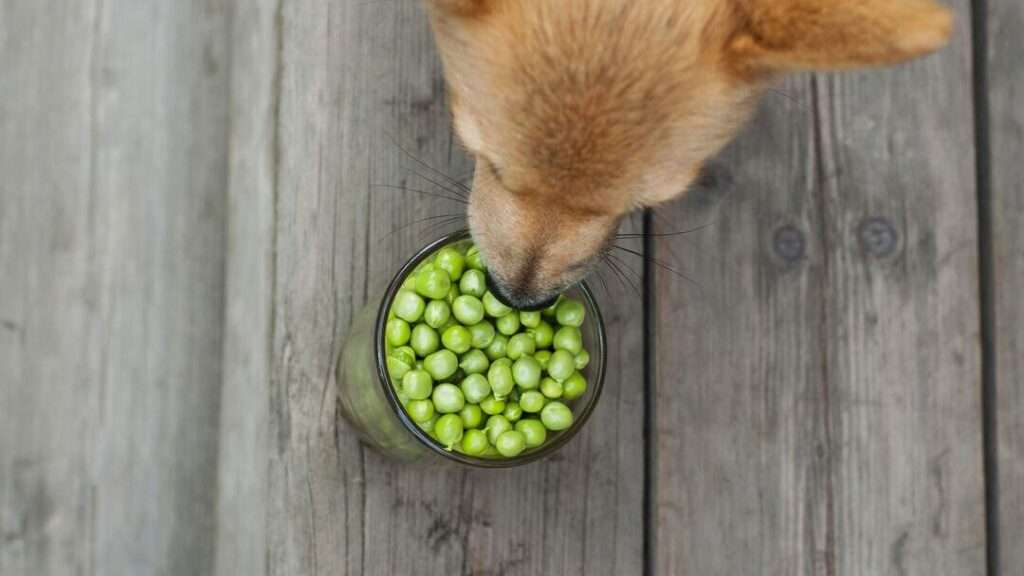Peas are a common vegetable found in kitchens around the world, known for their sweet taste and nutritional benefits. Many dog owners wonder if peas are safe for dogs and how to include them in a dog’s diet. In this detailed guide, we’ll explore everything you need to know about feeding peas to dogs, including types of peas, nutritional benefits, preparation tips, risks, and serving suggestions.

Are Peas Safe for Dogs?
Peas are typically safe for dogs when given in controlled amounts. They can be a nutritious part of a dog’s diet, providing essential vitamins, minerals, fiber, and protein. However, it is important not to overfeed them, as too many peas can cause digestive issues, gas, diarrhea, or vomiting, particularly in dogs who are not used to eating them.
Dogs of all ages, including puppies, adult dogs, and senior dogs, can enjoy peas, but portion control is essential. Small dogs, in particular, should only get a few peas at a time to prevent choking hazards.
Learn more about: Can dogs eat pickles
Types of Peas Dogs Can Eat
There are several types of peas that dogs can safely eat, each with slight differences in taste, texture, and nutritional profile:
- Green Peas: Classic garden peas, often boiled or steamed.
- Snow Peas: Flat, tender pods that can be chopped or mashed.
- Sugar Snap Peas: Sweet, crunchy peas that are easy to serve as a treat.
- Garden Peas: Small, round peas grown in pods.
- English Peas: Also known as shelling peas, they are typically shelled before feeding.
All these peas belong to the legume family or pulse family, making them rich in plant-based protein, fiber, and essential nutrients.
Nutritional Benefits of Peas for Dogs
Peas are packed with nutrients that support your dog’s digestion, heart health, and skin and coat condition. Here is why they make a beneficial addition to your dog’s diet:
- Vitamins: Peas contain vitamin A, C, and K, which help with immunity, vision, and bone health.
- Minerals: Essential minerals like iron, zinc, and manganese support metabolic functions.
- Fiber: Promotes healthy digestion by supporting regular bowel movements and preventing constipation.
- Protein: Plant-based protein helps maintain muscle mass.
- Antioxidants: Protect cells from damage and provide immune system support.
- Low-Calorie Snack: Ideal for weight management and low-fat diets.
By including peas in small amounts, you can enhance your dog’s balanced diet without adding unnecessary calories.
Health Benefits
Digestive Support
The high fiber content in peas supports healthy bowel movements and overall digestive function. Dogs with sensitive stomachs or minor digestive issues may benefit from gradual introduction of peas.
Weight Management
Peas are low in calories and fat, making them perfect for dogs on a weight management program. They provide a satisfying snack without the risks associated with high-fat treats.
Skin and Coat Health
Peas are packed with vitamins and antioxidants that help keep your dog’s skin healthy and coat glossy. Regular, moderate consumption can support dogs prone to skin rashes, itching, or allergies.
Heart Health
Nutrients like fiber, potassium, and antioxidants contribute to cardiovascular well-being, helping maintain a healthy heart in dogs of all sizes.
Potential Risks of Feeding Peas
Although peas are usually safe for dogs, there are a few potential risks to keep in mind:
- Choking Hazard: Whole peas can be hazardous, especially for small dogs. Always chop or mash them.
- Digestive Upset: Too many peas can cause gas, diarrhea, or vomiting.
- Allergic Reactions: Rare but possible. Watch for swelling, itching, skin rash, or difficulty breathing.
- Added Sodium or Preservatives: Steer clear of canned peas that contain extra salt or preservatives.
Dogs with pre-existing health conditions should have their diet reviewed by a veterinarian before introducing new foods like peas.
How to Safely Introduce Peas
Gradually introducing peas is essential to avoid digestive problems:
- Start with Small Quantities: Give a few peas at a time to observe tolerance.
- Gradual Introduction: Slowly increase serving size over several days.
- Observation: Keep an eye out for any allergic reactions or signs of digestive discomfort.
- Veterinary Consultation: Seek advice from a veterinarian, particularly for puppies, senior dogs, or dogs with existing health conditions.
Preparation and Serving Tips
Here are some tips to serve peas safely and deliciously for your dog:
- Raw Peas: Can be given in small amounts, though they may be more difficult for dogs to digest.
- Cooked Peas: Boiled or steamed peas are softer and easier to digest.
- Chopping or Mashing: Helps minimize the risk of choking, particularly for small dogs.
- Frozen Peas: Thawed and served as a cool treat in summer.
- Canned Peas: Safe to feed only when they contain no added salt or preservatives.
- Mixing with Dog Food: Can be added to commercial dog food for extra nutrients.
Avoid overcooking as it can reduce vitamin content. Always ensure peas are served plain, without sauces, butter, or seasonings.
Peas in Commercial Dog Food
Many commercial dog foods include peas as an ingredient due to their high protein and fiber content. Peas can replace or supplement grains in grain-free dog food formulas. They contribute to:
- Balanced Nutrition: Helps maintain healthy weight and digestion.
- Flavor and Texture: Adds palatability to dry and wet foods.
- Nutrient Boost: Supports immune system, skin, and coat health.
When choosing commercial dog food, check the ingredients list for peas and ensure no excessive sodium or preservatives are present.
FAQs
Yes, in moderation. Small portions can be included in daily meals, but avoid overfeeding to prevent digestive upset.
Absolutely. Frozen peas can be thawed and served as a refreshing treat. They retain most nutrients if not overcooked.
Yes, puppies can eat peas in small quantities. Begin by adding peas gradually to your dog’s diet and monitor for any allergic reactions or digestive issues.
Yes. Peas are low in calories, high in fiber, and provide protein, making them suitable for dogs on a low-fat or weight management diet.
Most dogs tolerate peas well, but monitor for allergic reactions such as itching, swelling, skin rash, or difficulty breathing. Consult a veterinarian if unsure.
Conclusion
When served in moderation, peas provide a healthy, safe, and low-calorie addition to your dog’s diet. With proper preparation and gradual introduction, peas can provide numerous health benefits, including digestive support, immune system support, weight management, and skin health.
Choose plain, fresh, or frozen peas, and steer clear of those containing added salt or preservatives. If your dog has health issues or dietary restrictions, check with your veterinarian before adding peas to their diet. Using these tips, you can safely include peas in your dog’s meals, providing a nutritious, safe, and tasty treat.

